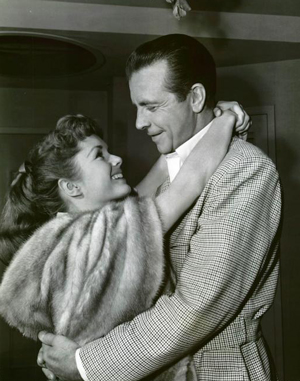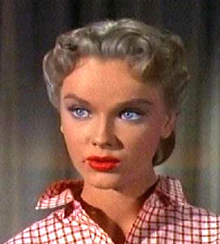
 |
|
|
|
When Frank Tashlin gets a mention it's usually in conjunction with the films he directed for Jerry Lewis. He was first acknowledged by the French critics that canonized individualistic directors Aldrich and Minnelli. As it turns out Tashlin's fingerprints are unmistakable on four decades' worth of screen comedy, from several dozen classic animated Warner Bros. cartoons to work that established or extended the screen personalities of the likes of Bob Hope, Jerry Lewis, Tony Randall and Doris Day. Beginning as a teenaged cartoonist who signed his work "Tash", Tashlin was a joke powerhouse who retained his graphic sensibilities when he moved to the big screen. His best-known Lewis & Martin film Artists and Models combined his love of cartooning with an equally developed appetite for glamorous women. The Lieutenant Wore Skirts tried to turn Sheree North into a backup for Marilyn Monroe, while the almost abstract The Girl Can't Help It makes Jayne Mansfield into a plastic sex object in a crazy culture dominated by rock 'n' roll. Elegance isn't a word that comes to mind when describing Tashlin, as his comedies seem to seek out new avenues of vulgarity. The protagonists in his sex comedies tend to be emasculated males like Lewis, and over-aged would-be Lotharios like Terry Thomas. Most of his screenplays dance around taboo subject matter, somehow managing to stay clear of utter tastelessness (and Production Code censure). Tashlin only directed 1954's Susan Slept Here but its script follows his personal preferences very closely. The touchy topic this time is a romance between a nearly middle-aged screenwriter and a 17 year-old runaway, a wildcat in a pony tale and blue jeans. RKO's ad campaign for the glossy Technicolor production never brings up the phrase, "Jail Bait". The script did go through several rounds at the Code Office, which was concerned about "possibly offensive" material. 
The show is partly narrated by an Oscar statuette earned by writer Mark Christopher (Dick Powell). Oscar's first remark is to envy another statuette tightly clutched by a starlet in a low-cut gown. Mark has quit his studio job to freelance and lives in a swank Hollywood high-rise with his support team, typist Maude Snodgrass (Glenda Farrell) and the cheerful Georgette (Maidie Norman), who serves as maid, housekeeper and cook. Mark's old Navy pal Virgil (Alvy Moore) has an ill-defined role as a general gofer. Besides drinking liquor, the main activity around the house/office seems to be advising Mark on his love life. Mark's Christmas Eve dinner plans with his fianceé Isabella (Anne Francis) are interrupted when two friendly cops arrive with the underage Susan Beauregard Landis (Debbie Reynolds). Arrested for vagrancy and disturbing the peace, Susan will probably have to spend a month in jail. But the cops know that Mark is looking for inspiration for a script, and suggest that he keep her for a couple of days. At first convinced that she's being shanghaied for illicit purposes, Susan eventually warms to Mark, whose entourage becomes concerned that he may cross the line into an illegal relationship. The furious Isabella does her best to break things up. Realizing that he can't let Susan go to jail, Mark instead marries her, with the intention of leaving her "unkissed" and undamaged for a quick annulment. Virgil "babysits" Susan while Mark's lawyer tries to get her to sign the papers. But Maude helps awaken Susan's true feelings -- she's in love and wants to make the marriage real. While Mark is away writing in a mountain cabin, the word spreads that Susan is pregnant ... and Mark suspects that Virgil might be the father. Susan Slept Here floats some pretty outlandish content. For a slick color production made at a time when real sex had to be kept under the carpet, its central tension comes from the sexual awakening of a bobbysoxer infatuated with a big-deal guy in the movies. Dick Powell's facial expressions, coupled with some racy dialogue, make no bones about Mark Christopher's sexual activities. He's avidly pursued by a man-eating Senator's daughter who's already chewed through several husbands -- Anne Francis is a delightfully stunning playgirl's playgirl. And although Debbie Reynolds' precocious teen is nobody's idea of a juvenile delinquent, she has a rather ravenous appetite for those physical pleasures she's not yet sampled. The dialogue is sharp and Tashlin doesn't reach for easy laughs by having characters waggle their eyebrows or hoot "Oo-la-la". We really wonder how Mark is going to keep Susan out of his bed. 
Susan Slept Here shows Tashlin an expert at juggling Production Code no-nos. The sincere emotional content is balanced by a weird comic sense that comes straight from the Looney Tunes. Powell lip-synchs the terrible dialogue from a movie playing on the TV, to an odd visual effect, while Debbie Reynolds makes fairly hilarious faces to mock Isabella in Mark's home movies. The two stars make an interesting pair. Mark is a more relaxed version of Dick Powell's cynical film noir characters, a strong and understanding guy too secure to defend himself when his friends find him in compromised situations with Susan. (Tashlin's original choice was Robert Mitchum.) Susan is of course the unsinkable Debbie Reynolds, a calculated performer who's an innocent Miss on the outside and a Sherman Tank on the inside. Her scream is strong enough to burst a Christmas ornament. When Susan puts her mind to snagging Mark for her own, we know that poor Isabella hasn't a prayer; she'll be knocked off like Debbie's Kathy Selden dismantled Lina Lamont. Reynolds is incapable of anything resembling natural acting but her professional skills are nothing to sniff at: Tashlin's gentle farce is a perfect fit for this powerhouse who played innocent young things almost into her thirties. What the above description doesn't prepare the viewer for is Susan Slept Here's pictorial qualities, which do indeed resemble reality filtered through the graphic sense of an animated cartoon. RKO's ace cameraman Nicholas Musuraca (better known for his B&W noir work) shoots Tashlin's sexy fantasy as if every shot were a special effect. Every Technicolor hue color pops, giving Reynolds "chroma appeal" -- her blonde hair and blue eyes almost leap off the screen. The sultry "babe next door" (Mara Lane) looks as if she stepped out of a four-color illustration in Playboy magazine. Mark's designer apartment might be the model for predatory wolves everywhere. Tashlin favors dynamic angles, shooting from floor level when Susan practices her golf putting, and letting characters swoop into close-up from the middle distance. The gags tease at sex, but not as strongly as a Tex Avery cartoon -- after listening to a romantic record, Susan cools down by sticking her head in the refrigerator! A simple close-up of Anne Francis in a pair of designer eyewear is a thing of beauty, an iconic '50s image. The colorful costumes and distinctive lighting leap to yet another level of stylization when Susan dreams of losing Mark to Isabella, who appears as a four-armed spider-woman. In the dream, Susan finds herself reduced to Thumbelina size and locked in a virtual gilded cage. Cartoonish dream sequences like this turn up in vehicles for a number of '50s stars, like Danny Kaye and Donald O'Connor, but there's no comparison. If Tashlin didn't design the sequence in detail, he certainly supervised it. I usually hate musical dream sequences of this kind -- Doris Day suffered through her share -- but this one is splendid. A few of the plot contrivances are trifling but the basic emotional thrust of Susan Slept Here is sound. Sidekick supporting actors Glenda Farrell and Alvy Moore cease being grating as the movie edges toward a warm & fuzzy finish. The romantic resolution is highly questionable, when Susan shows that she's learned to be suitable wife material by taking up various outdoors sports (imitating Isabella, actually) and learning how to mix drinks. The most important adjustment, never voiced but certainly communicated, is that Susan can now fill out a strapless gown like her sophisticated competition. Here it's just standard women's business, but a few pictures later in Will Success Spoil Rock Hunter?, insecurity over the decade's obsession with big breasts becomes a major issue for the sweet, relatively flat-chested Betsy Drake when she doesn't "measure up". Susan also has a scene in the office of a headshrinker, who immediately diagnoses Mark's romantic ills. Perhaps Frank Tashlin's "vulgar" obsessions in his '50s films don't seem offensive because he's honestly working out his private sex fantasies! 
Everybody looks great in Technicolor. Anne Francis is a knockout and Maidie Norman is so pretty, it now seems even more cruel for Robert Aldrich to have let Bette Davis kill her in What Ever Happened to Baby Jane? Although Ellen Corby is only on screen for a few seconds, serving Susan strawberries and pickles, Nicholas Musuraca makes her close-up a thing of beauty as well. Susan Slept Here expresses the good side of retro '50s culture nostalgia - Tashlin even finds room for a brief star cameo by Red Skelton. 
The Warner Archive Collection DVD-R of Susan Slept Here was recommended by a friend, and I can see why -- the "remastered" transfer is terrific! One couldn't ask for anything better in a standard DVD release, as the picture is a knockout, with colors that leap off the screen. After watching any number of truly garish color films, it's almost educational to see something so bright and gaudy, yet original and exciting looking. It's like seeing your first candy apple red hot rod, with lime green upholstery: now you know what was cool about the 1950s. I prefer Tashlin's taste in déor in this movie to that of Vincente Minnelli. The sound is equally bright and clear. Two scenes feature close-ups of a then brand-new hi-fi system playing an 33 & 1/3 rpm LP to promote singer Don Cornell. People to young to have marveled at the advent of Hi-fi stereo just can't understand the appeal. The image is enhanced at an aspect ratio of 1:66 (1.66:1, for purists). The disc includes a trailer transferred full frame, which demonstrates clearly how masking worked to produce widescreen images with flat prints -- look at the upper left of the frame during a 'chase around the room' trailer shot, and you'll see a large black lighting flag meant to be cropped out of the picture. Susan Slept Here is a star attraction for critics in love with the fetish-happy Frank Tashlin. I read one interpretation that suggests that Susan's arrival breaks up an unacknowledged homosexual alliance between Mark and Virgil (who at the end becomes "masculine" again and returns to the Navy). Back in 1954, The New York Times thought the film unexciting and not particularly funny; they even stomped on Leigh Harline's pleasant jazz score. Critics more receptive to the film's visual storytelling have since been far more receptive, and to the Tashlin cult the picture is a classic.
On a scale of Excellent, Good, Fair, and Poor,
Susan Slept Here rates:
Reviews on the Savant main site have additional credits information and are often updated and annotated with reader input and graphics. Also, don't forget the 2010 Savant Wish List. T'was Ever Thus.
Review Staff | About DVD Talk | Newsletter Subscribe | Join DVD Talk Forum |
| ||||||||||||||||||